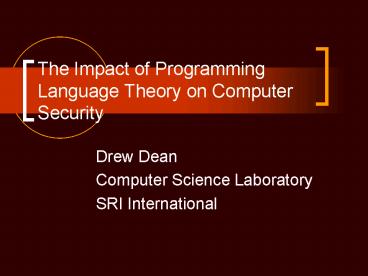The Impact of Programming Language Theory on Computer Security - PowerPoint PPT Presentation
Title:
The Impact of Programming Language Theory on Computer Security
Description:
See, e.g., Computer Security Foundations Workshop. Type Systems for ... 'Program P exactly implements Specification ... work with David Wagner and Hao Chen, UC ... – PowerPoint PPT presentation
Number of Views:23
Avg rating:3.0/5.0
Title: The Impact of Programming Language Theory on Computer Security
1
The Impact of Programming Language Theory on
Computer Security
- Drew Dean
- Computer Science Laboratory
- SRI International
2
What Im not Talking About
- Cryptographic Protocol Verification
- See, e.g., Computer Security Foundations Workshop
- Type Systems for Non-Interference
- See, e.g., POPL
3
Much of security is
- Program P exactly implements Specification S and
no more. - For this talk, we assume that the specification
is correct
4
Security Tripos
Correctness wrt critical requirements
No undefined user mode behavior
Proper system call use
5
Correctness wrt Security
- No system that misses security checks can be
secure - Program Verification
- Architectural Support
- Stack inspection
- Security Passing Style WAF
6
Program Verification
- Obvious connections
- Lambda calculus, Curry-Howard
- Hoare Logic
7
Architectural Support
- Stack Inspection
- Access control based on endorsement of code
answers Who called me? - Designed to prevent untrusted code from bypassing
access controls, while allowing higher level code
to assert that it knows what its doing
8
Stack Inspection Example
- Applet wants to use the Helvetica font
- May require JVM to read a file
- Solution
- Font handling code checks arguments
- If successful, asserts privilege
- Attempts to read file
- Which notes that font code (privileged) has
asserted everythings OK
9
Stack Inspection Critique
- Exposes call stack
- Tail call elimination painful
- Function inlining also painful
- Goodbye, Church-Rosser, goodbye!
10
Security Passing Style
- Wallach, Appel, Felten, TOSEM 9/00
- A la CPS, pass security context as an extra
(implicit) argument - Restores tail call elimination and function
inlining - Doesnt restore Church-Rosser
11
Observation
- SPS is in closer analogy to CPS than its authors
say - Shivers Threads are paths through continuation
space - Continuations are the right semantic object to
attach permissions to - Would a dependent type system work out?
12
Properly Using System Calls
- If a program handles its own security, e.g.,
ftpd, it better use system calls correctly - Many programs dont
- Wu-ftpd
- Sendmail
13
How Can PLT help?
- Joint work with David Wagner and Hao Chen, UC
Berkeley - Given a program, morph control flow graph into an
automaton that accepts language of system calls
14
IEEE SP 2001
- Take automaton, check runtime trace of system
calls for anomaly detection - (Most of) Benefits of specification-based
intrusion detection without needing the
non-existent spec
15
Current Work
- Take abstracted specification, throw it and
library of security best practices (and known
attacks) at (custom) model checker - But this requires understanding system calls
- Usually the POSIX spec is reasonable
- But not for setuid()
16
Understanding setuid
- Absolutely necessary for writing secure setuid
Unix programs - Linux, FreeBSD, Solaris all subtly different
- Even if all POSIX compliant
- Kernel code unreadable
- Reverse engineer formal model
- Will appear at USENIX Security 2002
17
No Undefined User-mode Behavior
- Buffer overflows are still a problem in 2002
- PL people think this is stupid
- It is
- Like it or not, most of the world codes in C or
unsafe C
18
Not Just Buffer Overflows
- Any corruption of program state can cause
vulnerability - Nearly science fiction attack based on a C
program double freeing a pointer
19
Observation
- Memory comes in two colors
- Storage of variables
- Compiler/runtime support
20
Partition Property
- All variables only refer to memory locations
that the compiler has mapped to program
variables, not compiler/runtime support (e.g.,
return addresses, temporaries for evaluating
expressions, memory management overhead, etc.)
21
Partition Properties
- Note that this is weaker than non-interference
- Values obviously depend on program values
- Stronger than some forms of memory type safety
- Should be a theorem of modern (safe) languages
22
Conclusions
- This was a brief survey of a wide field
- and no more is hard to implement
- Hopefully, breaking it down helps
Correctness wrt critical requirements
No undefined behavior
Proper system call use

